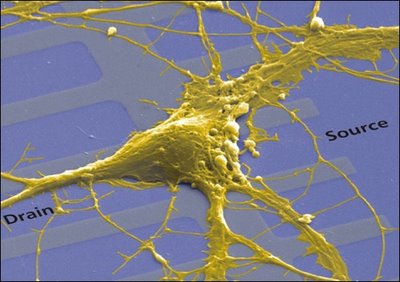
Discovery News reporta:
“La celula de un nervio de una rata conectada a un chip semicounductor intercambió una señal con ese chip. Un logro que podrá llevar a computadoras orgánicas que procesan información como un cerebro, dicen investigadores. En el largo plazo la tecnología podría ser usada para prostéticos que serán controlado por la mente del usario.”
Via: Make Magazine: News from the Future
Futuratrónics cross-index: Cerebro artificial de rata pilotea avion
Imagen: La neurona de la rata fusionada con la máquina
Futuratronics
20.4.06
Computadoras Organicas
Publicadas por
Andrés Hax
a la/s
4/20/2006
![]()
Suscribirse a:
Comentarios de la entrada (Atom)

1 comentario:
Rat Nerve Cell Pings Computer Chip
By Tracy Staedter, Discovery News
type size: [A] [A] [A]
April 19, 2006— A rat nerve cell attached to a semiconductor chip has exchanged a signal with the chip, an achievement that could lead to organic computers that process information like a brain, say researchers.
In the long term, the technology also could lead to prosthetic limbs that are controlled by a person's brain and nerves.
"If you know how single neurons couple to a chip, you can learn how whole tissue couples to a chip," said Peter Fromherz, professor of biophysics at Max Planck Institute for Biochemistry in Germany and coordinator of the so-called NaChip project, which also involves researchers from the University of Padua, Italy, and the University of Zurich, Switzerland.
To make the nerve cell and the chip compatible, the researchers worked with German microchip company Infineon to modify the chip's surface. The resulting one-millimeter chip has more than 16,000 transistors that match up with ion-carrying channels in the nerve cell.
The chips were specially coated so that they could be immersed in a solution meant to keep the nerve cell alive.
Next, the team zeroed in on the protein fibronectin, which is involved in many cellular processes, including tissue repair, blood clotting, and cell adhesion. The scientists grew the nerve cell on the protein and then used the protein to adhere the nerve to the silicon chip.
In addition to helping the cell adhere, the protein also served as a gate through which charged particles of sodium — the "Na" in NaChip — could move between the nerve and transistor.
By measuring the charge on the chip, the scientists confirmed that the electrical pulses from the active neuron were finding their way to it.
They were also able to stimulate the nerve cell by sending an electrical pulse from the chip's capacitors.
"From a major technology breakthrough point of view, the technique will revolutionize the way it's done," said professor Naweed Syed, head of the department of cell biology and anatomy at the University of Calgary.
Eventually, the NaChip team plans to move beyond the single rat cell to rat brain. According to Fromherz, the scientists have all of the tools to couple hundreds of neurons to a semiconductor chip and conceivably perform simple computations.
http://dsc.discovery.com/news/briefs/20060417/nervechip_tec_print.html
Publicar un comentario